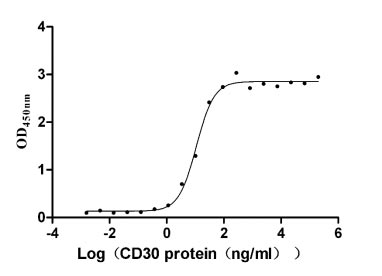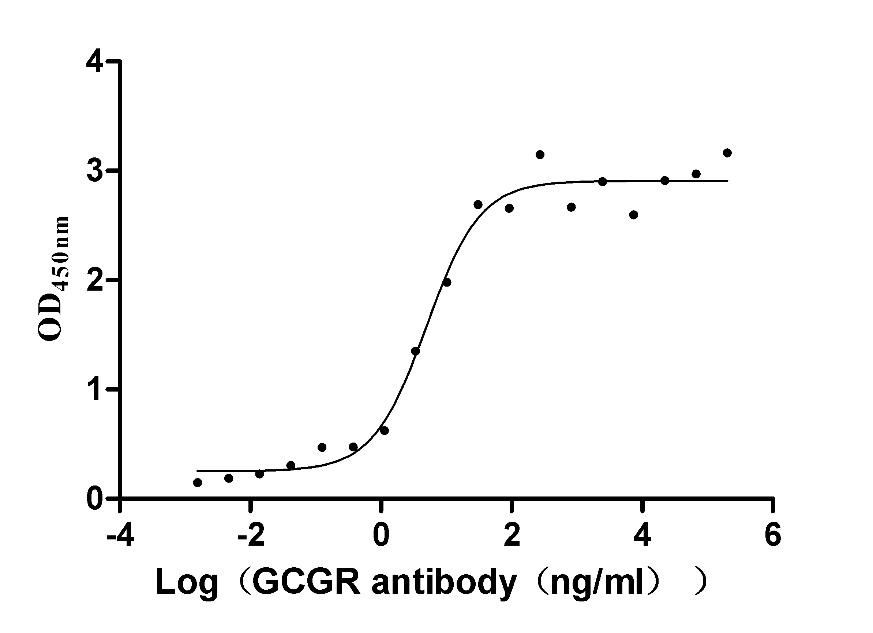Recombinant Mouse ATP-sensitive inward rectifier potassium channel 1 (Kcnj1), partial
-
中文名称:小鼠Kcnj1重组蛋白
-
货号:CSB-YP012047MO1
-
规格:
-
来源:Yeast
-
其他:
-
中文名称:小鼠Kcnj1重组蛋白
-
货号:CSB-EP012047MO1
-
规格:
-
来源:E.coli
-
其他:
-
中文名称:小鼠Kcnj1重组蛋白
-
货号:CSB-EP012047MO1-B
-
规格:
-
来源:E.coli
-
共轭:Avi-tag Biotinylated
E. coli biotin ligase (BirA) is highly specific in covalently attaching biotin to the 15 amino acid AviTag peptide. This recombinant protein was biotinylated in vivo by AviTag-BirA technology, which method is BriA catalyzes amide linkage between the biotin and the specific lysine of the AviTag.
-
其他:
-
中文名称:小鼠Kcnj1重组蛋白
-
货号:CSB-BP012047MO1
-
规格:
-
来源:Baculovirus
-
其他:
-
中文名称:小鼠Kcnj1重组蛋白
-
货号:CSB-MP012047MO1
-
规格:
-
来源:Mammalian cell
-
其他:
产品详情
-
纯度:>85% (SDS-PAGE)
-
基因名:Kcnj1
-
Uniprot No.:
-
别名:Kcnj1; ATP-sensitive inward rectifier potassium channel 1; ATP-regulated potassium channel ROM-K; Inward rectifier K(+ channel Kir1.1; Potassium channel, inwardly rectifying subfamily J member 1
-
种属:Mus musculus (Mouse)
-
蛋白长度:Partial
-
蛋白标签:Tag type will be determined during the manufacturing process.
The tag type will be determined during production process. If you have specified tag type, please tell us and we will develop the specified tag preferentially. -
产品提供形式:Lyophilized powder
Note: We will preferentially ship the format that we have in stock, however, if you have any special requirement for the format, please remark your requirement when placing the order, we will prepare according to your demand. -
复溶:We recommend that this vial be briefly centrifuged prior to opening to bring the contents to the bottom. Please reconstitute protein in deionized sterile water to a concentration of 0.1-1.0 mg/mL.We recommend to add 5-50% of glycerol (final concentration) and aliquot for long-term storage at -20℃/-80℃. Our default final concentration of glycerol is 50%. Customers could use it as reference.
-
储存条件:Store at -20°C/-80°C upon receipt, aliquoting is necessary for mutiple use. Avoid repeated freeze-thaw cycles.
-
保质期:The shelf life is related to many factors, storage state, buffer ingredients, storage temperature and the stability of the protein itself.
Generally, the shelf life of liquid form is 6 months at -20°C/-80°C. The shelf life of lyophilized form is 12 months at -20°C/-80°C. -
货期:Delivery time may differ from different purchasing way or location, please kindly consult your local distributors for specific delivery time.Note: All of our proteins are default shipped with normal blue ice packs, if you request to ship with dry ice, please communicate with us in advance and extra fees will be charged.
-
注意事项:Repeated freezing and thawing is not recommended. Store working aliquots at 4°C for up to one week.
-
Datasheet :Please contact us to get it.
相关产品
靶点详情
-
功能:In the kidney, probably plays a major role in potassium homeostasis. Inward rectifier potassium channels are characterized by a greater tendency to allow potassium to flow into the cell rather than out of it. Their voltage dependence is regulated by the concentration of extracellular potassium; as external potassium is raised, the voltage range of the channel opening shifts to more positive voltages. The inward rectification is mainly due to the blockage of outward current by internal magnesium. This channel is activated by internal ATP and can ...显示更多
-
基因功能参考文献:
- ENaC and ROMK channel activity in kidney tubules are inhibited in TgWnk4(pseudoaldosteronism type II) mice. Wnk4(PHAII)-induced inhibition of ENaC and ROMK may contribute to the suppression of K(+) secretion in the tubules. PMID: 28365586
- animal knockouts of ROMK1 do not produce Bartter phenotype. ROMK1 is critical in response to high K intake-stimulated K+ secretion in the collecting tubule. PMID: 26728465
- Lovastatin stimulates ROMK1 channels by inducing PI(4,5)P2 synthesis, suggesting that the drug could reduce cyclosporine-induced nephropathy. PMID: 25349201
- It was concluded that miR-194 regulates ROMK channel activity by modulating ITSN1 expression thereby enhancing ITSN1/WNK-dependent endocytosis. PMID: 24197061
- hypertension resistance sequence variants inhibit ROMK channel function by different mechanisms PMID: 20926634
- knockout mice have impaired renal NaCl absorption; a model for type II Bartter's syndrome PMID: 12122007
- Absence of small conductance K+ channel (SK) activity in apical membranes of thick ascending limb and cortical collecting duct in knockout mice a model for bartter's disease__ PMID: 12130653
- ROMK is required for functional expression of the 70-pS K channel in the thick ascending limb. PMID: 14600033
- mutant WNK4 does not have a dominant effect on the cellular localization of kidney ROMK PMID: 15907795
- The expression of ROMK channels in the plasma membrane is regulated by PTK, SGK, and with-no-lysine-kinase 4. A recent study indicated that ROMK channels can be monoubiquitinated and monoubiquitination regulates the surface expression of ROMK channels. PMID: 16339961
- Potassium absorption in the loop of Henle is reduced in Romk-deficient mice and can account for a significant fraction of renal potassium loss. PMID: 16710355
- mRNA expression of ROMK is augmented in the renal medullary tubule by NaCl-induced hypertonicity through stimulation of ROMK gene transcription, and that TonEBP and the p38 MAPK and ERK pathways are involved in this effect. PMID: 17003571
- Potassium restriction suppresses the expression of PP2B catalytic subunits and that inhibition of PP2B decreases ROMK channel activity. PMID: 18184875
- adaptive changes in Romk(-/-) mice may help to limit renal Na(+) loss PMID: 18322017
- absolute excretion of Na(+) and K(+) were significantly blunted in Romk(-/-) mice, consistent with a major salt transport defect in the thick ascending limb PMID: 18385266
- more severe Bartter phenotype in female ROMK null mice, and higher PGE(2) and TXB(2) production may be one of the mechanisms of this manifestation PMID: 18579648
- KS-WNK1 is an important physiological regulator of renal K(+) excretion, likely through its effects on the ROMK1 channel. PMID: 19244242
- cortical collecting duct cells demonstrate a significant K(+) secretion, probably mediated by ROMK, which is not stimulated by aldosterone but increased by overnight exposure to a high K(+) concentration PMID: 19297448
- We propose that in taste buds, ROMK in type I/glial-like cells may serve a homeostatic function, excreting excess K(+) through the apical pore, and allowing excitable taste cells to maintain a hyperpolarized resting membrane potential. PMID: 19708028
- ARH marks ROMK for clathrin-dependent endocytosis, in concert with the demands of potassium homeostasis PMID: 19841541
收起更多
-
亚细胞定位:Cell membrane; Multi-pass membrane protein.
-
蛋白家族:Inward rectifier-type potassium channel (TC 1.A.2.1) family, KCNJ1 subfamily
-
数据库链接:
KEGG: mmu:56379
STRING: 10090.ENSMUSP00000131625
UniGene: Mm.390168




















